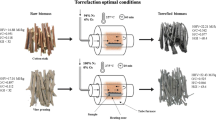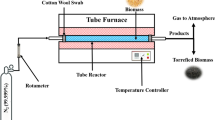Abstract
Increasing awareness due to climate change have been stimulating the development of renewable energies. Slow pyrolysis is considered a good method to produce high calorific value char, especially using lignin-rich sources. Along with calorific value, the ignition temperature is another important factor to classify biofuels as it is the minimum required temperature for self-sustaining combustion. Pyrolysis is responsible not only for improving the calorific value of biomass, but also for increasing its ignition, thus demanding more energy for char combustion. Therefore, the production of a char with energetic potential and improved combustibility is important. Here, chars produced at 300–700 °C and blended with biomass were evaluated according to their higher heating value (HHV) and ignition temperature by thermal analysis. The ash content of chars produced at higher temperatures limited their energetic potential. Depending on the ratio, blending char with biomass improved its combustibility without compromising its HHV.

Similar content being viewed by others
References
Decorato U, Debari I, Viola E, Pugliese M. Assessing the main opportunities of integrated biorefining from agro-bioenergy co/by-products and agroindustrial residues into high-value added products associated to some emerging markets: a review. Renew Sustain Energy Rev. 2018;88:326–46. https://doi.org/10.1016/j.rser.2018.02.041.
Marazza D, Macrelli S, D’Angeli M, Righi S, Hornung A, Contin A. Greenhouse gas savings and energy balance of sewage sludge treated through an enhanced intermediate pyrolysis screw reactor combined with a reforming process. Waste Manag. 2019;91:42–53. https://doi.org/10.1016/j.wasman.2019.04.054.
Yuan T, He W, Yin G, Xu S. Comparison of bio-chars formation derived from fast and slow pyrolysis of walnut shell. Fuel. 2020;261(2019):116450. https://doi.org/10.1016/j.fuel.2019.116450.
Uddin MN, Techato K, Taweekun J, Rahman MM, Rasul MG, Mahlia TMI, Ashrafur SM. An overview of recent developments in biomass pyrolysis technologies. Energies. 2018. https://doi.org/10.3390/en11113115.
Demirbaş A. Relationships between lignin contents and fixed carbon contents of biomass samples. Energy Convers Manage. 2003;44(9):1481–6. https://doi.org/10.1016/S0196-8904(02)00168-1.
Rodriguez Correa C, Hehr T, Voglhuber-Slavinsky A, Rauscher Y, Kruse A. Pyrolysis vs hydrothermal carbonization: Understanding the effect of biomass structural components and inorganic compounds on the char properties. J Anal Appl Pyrolysis. 2019;140:137–47. https://doi.org/10.1016/j.jaap.2019.03.007.
Yang H, Yan R, Chen H, Lee DH, Zheng C. Characteristics of hemicellulose, cellulose and lignin pyrolysis. Fuel. 2007;86(12–13):1781–8. https://doi.org/10.1016/j.fuel.2006.12.013.
Pereira BLC, Carneiro ADCO, Carvalho AMML, Colodette JL, Oliveira AC, Fontes MPF. Influence of chemical composition of eucalyptus wood on gravimetric yield and charcoal properties. BioResources. 2013;8(3):4574–92. https://doi.org/10.15376/biores.8.3.4574-4592.
de Lima ACP, Bastos DLR, Camarena MA, Bon EPS, Cammarota MC, Teixeira RSS, Gutarra MLE. Physicochemical characterization of residual biomass (seed and fiber) from açaí (Euterpe oleracea) processing and assessment of the potential for energy production and bioproducts. Biomass Convers Biorefinery. 2019. https://doi.org/10.1007/s13399-019-00551-w.
Pessoa JDC, Arduin M, Martins MA, de Carvalho JEU. Characterization of Açaí (E. oleracea) fruits and its processing residues. Braz Arch Biol Technol. 2010;53(6):1451–60. https://doi.org/10.1590/S1516-89132010000600022.
Sato MK, de Lima HV, Costa AN, Rodrigues S, Pedroso AJS, et al. Biochar from acai agroindustry waste: study of pyrolysis conditions. Waste Manag. 2019;96:158–67. https://doi.org/10.1016/j.wasman.2019.07.022.
Bufalino L, Guimarães AA, Silva BMDSE, De Souza RLF, De Melo ICNA, De Oliveira DNPS, Trugilho PF. Local variability of yield and physical properties of açaí waste and improvement of its energetic attributes by separation of lignocellulosic fibers and seeds. J Renew Sustain Energy. 2018;10(5):1. https://doi.org/10.1063/1.5027232.
Santos LA, et al. Methane generation potential through anaerobic digestion of fruit waste. J Clean Prod. 2020;256: 120389. https://doi.org/10.1016/j.jclepro.2020.120389.
Magalhães D, Kazanç F, Ferreira A, Rabaçal M, Costa M. Ignition behavior of Turkish biomass and lignite fuels at low and high heating rates. Fuel. 2017;207(x):154–64. https://doi.org/10.1016/j.fuel.2017.06.069.
Basu P. Chapter 2—biomass characteristics. In: Basu P, editor. Biomass gasification and pyrolysis: practical design and theory. Boston: Academic Press; 2010. p. 27–63.
Parshetti GK, Quek A, Betha R, Balasubramanian R. TGA—FTIR investigation of co-combustion characteristics of blends of hydrothermally carbonized oil palm biomass ( EFB ) and coal. Fuel Process Technol. 2014;118:228–34. https://doi.org/10.1016/j.fuproc.2013.09.010.
Parikh J, Channiwala SA, Ghosal GK. A correlation for calculating HHV from proximate analysis of solid fuels. Fuel. 2005;84(5):487–94. https://doi.org/10.1016/j.fuel.2004.10.010.
Malucelli LC, Silvestre GF, Carneiro J, Vasconcelos EC, Guiotoku M, Maia CMBF, Carvalho Filho MAS. Biochar higher heating value estimative using thermogravimetric analysis. J Therm Anal Calorim. 2019. https://doi.org/10.1007/s10973-019-08597-8.
Issac M, De Girolamo A, Dai B, Hosseini T, Zhang L. Influence of biomass blends on the particle temperature and burnout characteristics during oxy-fuel co-combustion of coal. J Energy Inst. 2019. https://doi.org/10.1016/j.joei.2019.04.0141.
Lu JJ, Chen WH. Investigation on the ignition and burnout temperatures of bamboo and sugarcane bagasse by thermogravimetric analysis. Appl Energy. 2015;160:49–57. https://doi.org/10.1016/j.apenergy.2015.09.026.
Lin Y, Ma X, Peng X, Hu S, Yu Z, Fang S. Effect of hydrothermal carbonization temperature on combustion behavior of hydrochar fuel from paper sludge. Appl Therm Eng. 2015;91:574–82. https://doi.org/10.1016/j.applthermaleng.2015.08.064.
Qiguo Y, Qi F, Hu Z. Thermogravimetric analysis of co-combustion of biomass and biochar. Thermogravim Anal Co-Combusti Biomass Biochar. 2012. https://doi.org/10.1007/s10973-012-2744-1.
Mierzwa-Hersztek M, Gondek K, Jewiarz M, Dziedzic K. Assessment of energy parameters of biomass and biochars, leachability of heavy metals and phytotoxicity of their ashes. J Mater Cycles Waste Manage. 2019;21(4):786–800. https://doi.org/10.1007/s10163-019-00832-6.
Mimmo T, Panzacchi P, Baratieri M, Davies CA, Tonon G. Effect of pyrolysis temperature on miscanthus (Miscanthus × giganteus) biochar physical, chemical and functional properties. Biomass Bioenerg. 2014;62:149–57. https://doi.org/10.1016/j.biombioe.2014.01.004.
Atienza-Martínez M, Ábrego J, Gea G, Marías F. Pyrolysis of dairy cattle manure: evolution of char characteristics. J Anal Appl Pyrolysis. 2019. https://doi.org/10.1016/j.jaap.2019.104724.
Almeida S, Crespi MS, Nozela WC, Dias DS, Silva FR, Torquato LDM, Ribeiro CA, Marchi MRR. Food waste: energy source. J Therm Anal Calorim. 2018;134(2):1367–73.
Cruz G, Crnkovic PM. Investigation into the kinetic behavior of biomass combustion under N2/O2 and CO2/O2 atmospheres. J Therm Anal Calorim. 2016;123(2):1003–11. https://doi.org/10.1007/s10973-015-4908-2.
Todaro L, Rita A, Cetera P, D’Auria M. Thermal treatment modifies the calorific value and ash content in some wood species. Fuel. 2015;140:1–3. https://doi.org/10.1016/j.fuel.2014.09.060.
White RH. Effect of lignin content and extractives on the higher heating value of wood. Wood Fiber Sci. 2007;19(4):446–52.
Malucelli LC, Carneiro J, Vasconcelos EC, Magalhães WLE, Murakami FS, Carvalho MAS. Energetic potential of pyrolyzed biomass from different sources: a comparative study. J Therm Anal Calorim. 2019. https://doi.org/10.1007/s10973-019-09061-3.
Luiz J, Alves F, Constantino J, Da G, Davi G, Domenico MD, et al. Insights into the bioenergy potential of jackfruit wastes considering their physicochemical properties, bioenergy indicators, combustion behaviors, and emission characteristics. Renew Energy. 2020. https://doi.org/10.1016/j.renene.2020.04.025.
Author information
Authors and Affiliations
Corresponding author
Additional information
Publisher's Note
Springer Nature remains neutral with regard to jurisdictional claims in published maps and institutional affiliations.
Rights and permissions
About this article
Cite this article
Malucelli, L.C., Guiotoku, M., Maia, C.M.B.F. et al. Optimal blending to improve the combustibility of biofuels: a waste-to-energy approach. J Therm Anal Calorim 147, 5771–5777 (2022). https://doi.org/10.1007/s10973-021-10955-4
Received:
Accepted:
Published:
Issue Date:
DOI: https://doi.org/10.1007/s10973-021-10955-4




